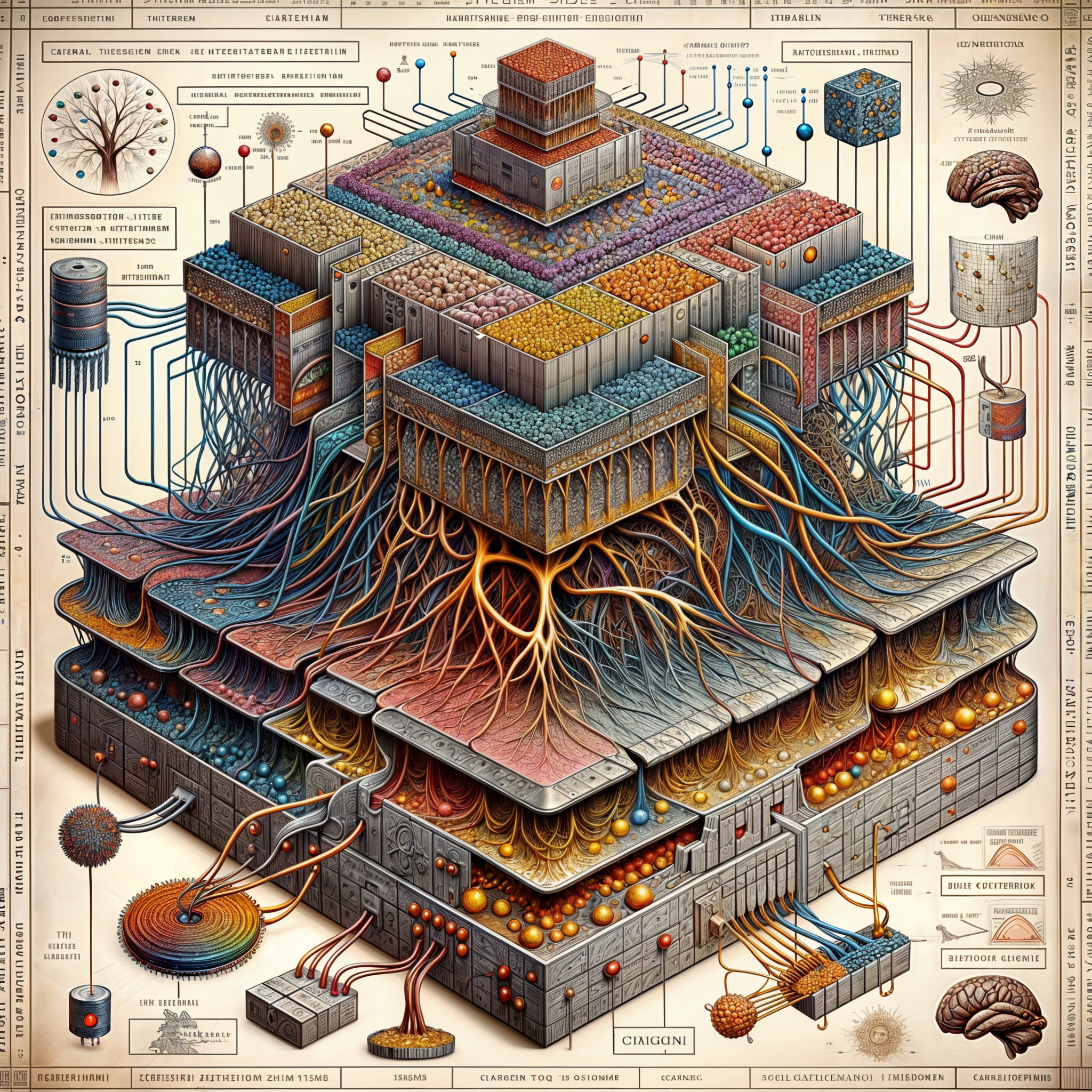Last Updated on February 28, 2024 3:06 pm by Laszlo Szabo / NowadAIs | Published on February 28, 2024 by Laszlo Szabo / NowadAIs
How Large Language Models Work – LLMs Explained – Key Notes:
- Large Language Models (LLMs) are central to AI advancements, particularly in natural language processing tasks.
- They are known for their vast model size and ability to grasp and predict the nuances of human language.
- Employing deep learning techniques, LLMs can perform tasks like content summarization, text generation, and predictions based on input context.
- Modern LLMs utilize transformer models, a neural network revolutionizing language processing by focusing on important parts of data.
- LLMs have various applications, including text generation, translation, summarization, and more, across different sectors.
Introduction – How Large Language Models Work?
In an era defined by technological innovation, the role of Large Language Models (LLMs) in advancing the field of Artificial Intelligence is becoming increasingly pivotal.
These sophisticated machine learning models are the powerhouse behind the generation of plausible language, predicting the likelihood of a token or sequence of tokens within a larger corpus.
With capabilities stretching from language translation to sentiment analysis, LLMs stand at the forefront of cutting-edge AI.
Their scope is epitomized by models like BERT, which boasts 110 million parameters, expanding to the colossal 340 billion parameters of models such as PaLM 2.
Such prowess underscores the essence of what is a large language model and why understanding LLMs has never been more crucial.
Delving into the mechanics of these models reveals a transformation in language processing through innovations like transformers, which address previous memory constraints by emphasizing crucial parts of the input data.
These advancements facilitate a breadth of applications across various sectors, incorporating LLM AI technology into tools offered by cloud services like AWS, including Amazon Lex and Amazon Polly.
This article aims to explore LLM meaning and function, unravel the complexities of how do large language models are typically work, assess their significance in natural language processing, identify their challenges, and predict the next advancements.
By illuminating the integral role of LLMs in our digital discourse, readers will garner a comprehensive understanding of the state of LLM machine learning and its multifaceted impact on industries ranging from robotics to content creation.
Defining Large Language Models (LLMs)
At the heart of AI advancements, Large Language Models (LLMs) serve as the backbone for a myriad of Natural Language Processing (NLP) tasks.
These are characterized by their extensive model size and capacity for understanding and predicting human language nuances.
Here, we delve into the core aspects that define LLMs:
Core Definition and Functionality
A Large Language Model (LLM) employs Deep Learning techniques to process vast amounts of text data. This allows the language model’s performance in tasks such as summarizing content, generating new text, and offering predictions based on the context of the input data.
As a subset of Generative AI, LLMs are adept at creating text-based content that can range from answering questions to composing entire articles.
Structural and Operational Characteristics
The inception of modern LLMs dates back to 2017, with the introduction of transformer models, a type of neural network that has revolutionized the way machines process language data.
The defining feature of LLMs is the sheer number of parameters they contain, often exceeding one billion. These parameters are the learned variables on which the model bases its text generation and understanding capabilities of language models.
Variants and Applications
LLMs come in various forms, each tailored to specific tasks or industries:
- Zero-shot models that can handle tasks without prior examples.
- Fine-tuned models that have been specifically trained for certain domains.
- Language representation means a model can understand context and semantics.
- Multimodal models that can interpret and generate content that combines text with other data types like images or sounds.
The use cases for LLMs span across text generation, translation, summarization, content rewriting, classification, sentiment analysis, and conversational interfaces, among others.
Advantages and Limitations
The benefits of employing LLMs include their adaptability to new tasks (extensibility), their ability to perform across various domains (flexibility), and their high level of performance and accuracy in language understanding tasks.
However, challenges such as the high costs associated with development and operation, potential biases in the generated content, issues with explainability, and the occurrence of hallucinations or glitch tokens pose significant hurdles.
By understanding these foundational elements, one can appreciate the complexity and potential of LLMs in AI, which are instrumental in shaping the future of machine learning and artificial intelligence.
The Evolution of LLMs – from Hidden Markov Models to Generative AI and ChatGPT
The early stages of NLP, dating back to the 1950s and 1960s, were marked by rule-based systems and statistical methods.
These were the precursors to what would eventually evolve into modern LLMs.
During this period, the focus was on developing algorithms that could mimic the basic structures of language, albeit in a very rudimentary form.
1980s to 1990s: Statistical Models
Hidden Markov Models (HMMs) and N-grams became the standard tools for language prediction.
These models relied on the statistical likelihood of word sequences, which, while effective to a degree, lacked the depth of understanding necessary for more complex language tasks.
The turn of the century saw a resurgence in neural networks, thanks to the refinement of the backpropagation algorithm.
This paved the way for feed-forward neural networks, which introduced a more dynamic approach to language modeling. However, it wasn’t until the advent of the Transformer architecture in 2017 that LLMs truly began to flourish.
This innovative approach allowed for parallel processing of sequences and effective management of long-range dependencies in text.
2000s: Neural Networks’ Resurgence
The early 2000s witnessed neural networks gaining momentum, with feed-forward architectures laying the groundwork for future developments in LLMs.
2017 Onwards: Transformer Models
The Transformer deep neural network architecture revolutionized LLMs by enabling parallel processing and managing extensive dependencies.
The introduction of models like Google’s BERT in 2019 and GPT-3 in 2020, with an unprecedented 175 billion parameters, marked a significant leap in the capabilities of LLMs.
The emergence of ChatGPT towards the end of 2022 further highlighted the sophistication of these models in understanding and generating human-like text.
These LLMs are foundation models, which means they are trained on vast amounts of data to generate or embed text, often conditioned by a given prompt.
Recent Milestones in LLMs
Google’s BERT and OpenAI’s GPT-3 and ChatGPT are among the notable LLMs that have set new standards for language understanding and generation capabilities.
LLMs are now capable of performing a wide array of tasks, from sentiment analysis and text categorization to language translation and summarization.
Their ability to develop emergent skills, such as in-context learning, allows them to execute tasks without explicit prior programming—an attribute that underscores their advanced AI capabilities.
Capabilities of Modern LLMs
Tasks such as sentiment analysis, text categorization, and summarization are within the purview of current LLMs.
Emergent abilities like in-context learning enable LLMs to perform tasks without being explicitly programmed for them.
Moreover, the performance of LLMs can be enhanced through various techniques such as chain-of-thought prompting, model calibration, and program execution.
These methods contribute to the refinement of LLMs, making them more adept at handling complex language-based tasks.
Enhancing LLM Performance
Techniques like chain-of-thought prompting and model calibration are instrumental in improving the efficacy of LLMs in complex language tasks.
In summary, the evolution of LLMs is a testament to the remarkable strides made in the field of artificial intelligence, particularly within the realm of natural language processing.
From their statistical beginnings to the current state-of-the-art models, models continue to redefine the boundaries of what machines can understand and generate human language text.
How LLMs Work Exactly – Language Models Trained on Transformer Models
Large Language Models (LLMs) operate on the cutting edge of Artificial Intelligence, harnessing the power of deep learning models to process and generate human-like text.
Their functionality is rooted in a complex interplay of algorithms and neural network architectures, particularly transformers, which are pivotal in understanding context and managing long-range dependencies in language.
Here is a breakdown of how these sophisticated models work:
Neural Network Foundations
- Neural Networks: LLMs are built upon neural networks, which are computing systems vaguely inspired by the biological neural networks that constitute animal brains. These networks are composed of interconnected nodes, or “neurons,” which process information using a set of learned weights and biases.
- Transformers: A key component in the architecture of LLMs is the transformer model. These are designed to handle sequential data and are particularly adept at managing the context within language for tasks like translation and content generation.
Training Process
- Data Ingestion: LLMs begin their training by ingesting vast amounts of text data, learning from a variety of sources to understand language patterns and structures.
- Pattern Recognition: Through this training process, LLMs analyze the text data to identify relationships between words and phrases, effectively learning how language is used in different contexts.
- Computational Resources: The training of an LLM is a resource-intensive process, often requiring significant computational power and time, sometimes extending to weeks, to reach a satisfactory level of understanding and accuracy.
Fine-Tuning and Applications
- Task-Specific Fine-Tuning: While LLMs come with a broad understanding of language, they can be fine-tuned for specific tasks or domains, enhancing their performance in areas such as medical text analysis or legal document review.
- Generative Capabilities: Equipped with this fine-tuned knowledge, LLMs can generate text that is coherent and contextually relevant, making them valuable for applications in virtual assistants, content creation, and translation services.
Addressing Bias and Misuse
- Bias Mitigation: The outputs of LLMs can reflect biases present in the training data. To combat this, balanced training datasets and post-processing filters are employed to ensure fairness and neutrality in the generated text.
- Preventing Misuse: As with any powerful technology, there is potential for misuse. LLMs could be used to generate misleading information or spam. To prevent such scenarios, content filters and monitoring systems are vital to ensure the responsible use of these models.
In summary, the operation of large language models is a complex process that involves the intricate analysis of language patterns, extensive training on diverse datasets, and the use of advanced neural network architectures. Their ability to understand and generate text has a broad spectrum of applications, although care must be taken to address potential biases and misuse.
LLM Applications – Potential of AI Chatbots

Large language models (LLMs) have a wide array of applications that leverage their ability to understand, generate, and process language in a manner that closely mimics human capabilities.
These applications span various industries and functions, demonstrating the versatility and transformative potential of LLMs in the realm of artificial intelligence.
Below are some of the key applications:
Content Generation:
LLMs have the capacity to automate the creation of diverse written materials, such as articles and social media posts, by generating coherent and contextually appropriate text from given natural language prompts.
For instance, models like Claude and ChatGPT exemplify how these models can be utilized for efficient and scalable content production.
Translation and Localization:
The advanced capabilities of LLMs extend to providing translations that are not only linguistically accurate but also culturally and contextually adapted.
This is particularly valuable for global businesses that need to communicate effectively across language barriers.
Models like Falcon LLM and NLLB-200 serve as prime examples of how LLMs can facilitate seamless communication in a multilingual world.
Search and Recommendation:
LLMs enhance the accuracy and relevance of search results by processing natural language queries with a high degree of understanding.
They also contribute significantly to recommendation systems, personalizing content suggestions based on user interactions and preferences.
- Virtual Assistants: AI-driven virtual assistants powered by LLMs, such as Amazon’s Alexa and Google Assistant, are transforming the way users interact with technology by enabling more intuitive and natural conversations, streamlining customer support, and improving accessibility through advanced natural language processing.
- Code Development: In the realm of software development, LLMs assist programmers by offering code completions, reviewing code snippets, and translating code across different programming languages. StarCoder is a notable example of an LLM aiding in the code development process.
- Sentiment Analysis: Businesses leverage LLMs to extract sentiment from text data, such as social media posts and customer feedback. This allows for a deeper understanding of customer sentiments, aiding in strategy formulation. Tools like Grammarly utilize LLMs to provide insights into written communication.
- Question Answering: LLMs are adept at providing precise and relevant answers to questions across various platforms, from search engines to educational tools. An example of this application is LLaMA 2, which demonstrates the question-answering capabilities of LLMs.
- Market Research: In market research, LLMs analyze customer feedback and other data to identify trends and patterns, predict market movements, and summarize complex data into actionable insights. Brandwatch and Talkwalker are examples of platforms that utilize LLMs for in-depth market analysis.
These applications illustrate the multifaceted nature of LLMs and their growing influence across different sectors.
By leveraging their advanced language processing capabilities, LLMs are not just augmenting current processes but are also paving the way for innovative approaches to problem-solving and communication in the digital age.
Challenges and Limitations of LLMs
Despite the transformative potential of large language models (LLMs) in various applications, several challenges and limitations persist that must be addressed to ensure their responsible and effective deployment:
Data Privacy and Security Concerns:
The need for massive datasets to train LLMs can inadvertently involve sensitive information, especially when applied in enterprise settings. To safeguard this data, stringent security protocols such as encryption, data masking, and stringent access controls are imperative.
Integration with Existing Systems:
Managing and integrating the data output from LLMs into existing systems can present logistical hurdles. Effective solutions for the storage and management of this data are essential to ensure its accessibility and utility in enhancing current systems.
Cost Implications:
The deployment of LLMs entails substantial costs associated with hardware, software, and ongoing maintenance. Organizations must evaluate whether they possess the requisite budget and infrastructure to support the implementation of LLMs.
Skills Shortage:
A scarcity of professionals with expertise in LLMs poses a significant challenge. Investment in comprehensive training and development programs is crucial to equip teams with the skills needed for effective LLM utilization.
Bias and Hallucination:
LLMs have the propensity to produce biased outputs or “hallucinations” if the training data contains inherent biases. It’s essential that predicted results are validated against actual data to ensure the accuracy and fairness of the content generated.
Model Transparency and Explainability:
The complex “black box” nature of LLMs can obscure the understanding of their decision-making processes. Research into improving the explainability and transparency of these models is vital for gaining trust and facilitating wider adoption.
Generalization and Contextual Understanding:
Enhancing the ability of LLMs to generalize across different contexts and understand complex linguistic structures remains an ongoing challenge in the field.
Resource Consumption and Environmental Impact:
The extensive computational resources required for training and operating LLMs have a considerable environmental impact. Ongoing research aims to reduce the environmental footprint of LLMs without compromising their performance.
Addressing these challenges is critical for the advancement and responsible application of LLMs in various sectors, including robotics, content creation, and conversational AI. As the field of artificial intelligence continues to evolve, so too must the strategies for mitigating the limitations of these powerful language learning models.
Future of LLMs
The future of large language models (LLMs) is poised to further enhance their utility and sophistication in various domains, including robotics, content creation, and conversational AI. Key developments in this area include:
Self Fact-Checking Capabilities:
Upcoming LLMs are being designed with the ability to verify the information they generate by accessing external resources. This not only improves the reliability of the information provided but also adds a layer of accountability to the models.
Models like Google’s REALM and DeepMind’s Sparrow are at the forefront of this advancement, demonstrating the potential for LLMs to serve as both generators and validators of knowledge.
Fine-Tuning and Alignment Innovations:
The introduction of Reinforcement Learning from Human Feedback (RLHF) marks a significant shift in how LLMs can be fine-tuned. This method leverages user feedback to train a reward model, allowing the LLM to align more closely with human preferences and values.
Such fine-tuning techniques are integral to models like ChatGPT, enhancing the model’s ability to provide responses that are not only accurate but also contextually appropriate and ethically aligned with user expectations.
Generation of Training Data Sets:
To address the limitations inherent in their training data, new research is enabling LLMs to generate their own training data sets. This self-improvement approach has the potential to mitigate issues such as bias and data scarcity.
Google’s self-improving model exemplifies this direction, where the LLM can refine its training data to improve how models perform and adapt to new tasks over time.
Development of Sparse Expertise Models:
Sparse expertise models represent an evolution in LLM design, where only a subset of parameters relevant to a particular prompt is activated. This approach leads to more efficient processing and reduced environmental impact.
An example of this type of model is Google’s GLaM, which boasts 1.2 trillion parameters and demonstrates how LLMs can be both powerful and sustainable.
Smaller, More Efficient Language Models (SLMs):
The development of SLMs is focusing on creating models that can operate on devices with limited processing capabilities. These models offer the potential for deployment on edge devices and can be optimized for specific domains or tasks.
The move towards SLMs indicates a trend of specialization within the field of LLMs, where models are tailored to specific applications while maintaining efficiency and effectiveness.
These advancements in LLM technology underscore the ongoing efforts to create models that are not only more powerful but also more responsible and adaptable to the nuanced demands of various applications. As LLMs continue to evolve, they hold the promise of transforming the landscape of machine learning and artificial intelligence, making them more accessible, reliable, and integral to our digital lives.
LLM Models Used in Research and Development
In the realm of research and development (R&D), Large Language Models (LLMs) are proving to be invaluable tools.
These models, which are foundational in nature, are leveraged for a multitude of NLP and NLG tasks.
Their adaptability is further enhanced through fine-tuning methodologies, enabling them to be specialized for a variety of downstream tasks. Here is how LLMs are influencing R&D across industries:
Streamlining Research Processes:
LLMs facilitate the summarization of complex scientific concepts and evidence, which allows researchers to access a condensed version of extensive resources. The efficiency of these summaries, however, is contingent upon the quality of the underlying training data.
The ability to generate and adapt content aids in the drafting of scientific texts. Nevertheless, human intervention is often necessary to refine the outputs of LLMs, which may be inaccurate or lack depth.
Enhancing Innovation and Decision-Making:
Through the analysis of vast data sets, LLMs can offer creative suggestions and understand context, which empowers R&D teams to venture into new areas of innovation and make more informed decisions.
LLMs contribute to the R&D decision-making process by identifying new opportunities, helping to establish strategic objectives, resource allocation, and project selection.
Improving Efficiency and Creativity:
By assimilating information from scientific papers, patents, industry reports, and market trends, LLMs provide valuable insights and detect emerging patterns, thereby enhancing the R&D process.
Acting as virtual brainstorming partners, LLMs increase the creativity and diversity of ideas within R&D teams, leading to more dynamic and innovative outcomes.
In the context of R&D, the two-stage training of LLMs—pre-training followed by fine-tuning—requires significant computational resources initially but becomes more cost-effective during the fine-tuning phase, which uses less data and power.
Despite their advantages, LLMs in R&D face challenges such as ensuring reliability, overcoming biases, managing high system costs, and addressing environmental impacts.
As the field of Artificial Intelligence evolves, the role of LLMs in R&D is expected to expand, with ongoing efforts to improve their performance and mitigate limitations.
Comparing LLMs with Traditional Models
When evaluating the distinctions between Large Language Models (LLMs) and traditional language models, it is crucial to consider their structural and operational differences, which have substantial implications for their performance in natural language processing tasks:
Architectural and Functional Comparison
- Foundational Architecture: LLMs are grounded in the advanced Transformer architecture, which utilizes self-attention mechanisms. This design enables LLMs to effectively capture long-range dependencies and comprehend the subtleties of language and context, a capacity that traditional models do not inherently possess.
Traditional models are built on statistical methods and n-gram approaches, which can only provide a limited understanding of complex semantic and syntactic structures due to their reliance on the probability of word sequences. - Learning and Adaptability: Deep learning capabilities inherent in LLMs allow them to learn complex linguistic features and hierarchical patterns through multiple layers. This attribute significantly outperforms traditional models in grasping the intricacies of language.
LLMs utilize a two-step process involving pretraining on large datasets and subsequent fine-tuning to adapt to specific tasks. Traditional models, conversely, rely on handcrafted features and predefined rules, which can limit their adaptability and scalability.
Industry-Specific Practical Applications and Efficiency
In specialized applications such as legal contract review, LLMs have demonstrated the ability to match or even exceed human accuracy levels.
They can complete reviews in seconds and operate at a fraction of the cost compared to traditional methods, marking a significant transformation in industries like legal services.Traditional AI systems, while less versatile than LLMs, excel in executing well-defined tasks with deterministic outcomes.
They are also more resource-efficient, making them suitable for scenarios with limited computational resources or where real-time decision-making is paramount.
Decision-Making Factors for Model Selection
The choice between LLMs and traditional models should be informed by the specific requirements and constraints of the application at hand. Factors to consider include the need for well-defined rules, deterministic processes, structured data, transparency, cost constraints, and interpretability.
For tasks requiring complex text generation, conversational AI, or in-depth natural language understanding, LLMs may be the preferred choice. In contrast, for applications that demand high levels of security, predictability, and efficiency, traditional models might be more appropriate.
In conclusion, while LLMs represent a significant advancement in the field of AI, particularly for tasks involving complex language processing, traditional models still hold value in certain contexts where predictability and efficiency are paramount.
The decision to employ LLMs or traditional models should be guided by a thorough assessment of the task requirements, available resources, and desired outcomes.
Conclusion
As we have explored, Large Language Models (LLMs) are transformative entities in AI, offering remarkable capabilities in understanding and generating human-like text.
They have evolved from early rule-based systems to current sophisticated models with billions of parameters, such as BERT and GPT-3.
Their integration into a multitude of industries has exemplified versatility and opened up new horizons for content creation, translation services, and even code development, foregrounding them as a staple in the advancement of natural language processing.
Nevertheless, the adoption of LLMs is not without its challenges. Issues such as data privacy, cost, integration, and mitigating bias require diligent attention to ensure ethical and effective use.
The ongoing research and development aimed at enhancing the efficiency, explainability, and applications of LLMs promise to mitigate these limitations.
As we look to the future, LLMs stand ready to redefine AI’s boundaries, making their thoughtful development and application essential for a progressively digital society.
Definitions:
- Large Language Model: A type of AI that processes and generates human-like text by analyzing vast amounts of data, using deep learning to predict language patterns.
- Machine Learning: A subset of AI that allows systems to learn and improve from experience without being explicitly programmed.
- Deep Learning: An advanced machine learning technique that involves neural networks with many layers, enabling the processing of large amounts of complex data.
- Artificial Intelligence (AI): The simulation of human intelligence processes by machines, especially computer systems, to perform tasks that typically require human intellect.
- Natural Language Processing (NLP): A field of AI focused on the interaction between computers and humans through natural language, enabling computers to understand, interpret, and generate human language.
- Transformer Models: A type of neural network architecture that has been highly influential in the development of LLMs, known for handling sequential data and understanding context within language efficiently.
- Research and Development (R&D): The investigative activities a business conducts to improve existing products and procedures or to lead to the development of new products and procedures.
Frequently Asked Questions:
- What is a Large Language Model (LLM)?
A Large Language Model is an AI system designed to understand, predict, and generate human language by analyzing extensive text data. - How do Large Language Models benefit industries?
They automate and enhance tasks like content creation, translation, and customer service across various industries. - Can anyone use a Large Language Model?
Yes, developers and businesses can access LLMs through APIs provided by companies, integrating AI capabilities into their services. - What makes Large Language Models unique in AI?
Their extensive training on diverse datasets allows them to understand and generate complex language patterns accurately. - How are Large Language Models trained?
They are trained on vast amounts of text data using deep learning techniques, particularly transformer models, to grasp language nuances. - What challenges do Large Language Models face?
They deal with issues like data bias, high operational costs, and the need for substantial computational resources. - Can Large Language Models understand different languages?
Many LLMs are trained to handle multiple languages, making them versatile tools for global applications. - How do Large Language Models impact content creation?
They significantly streamline content generation processes, offering efficient and scalable solutions for producing written material. - What is the future of Large Language Models?
Ongoing research aims to make LLMs more accurate, efficient, and capable of handling even more complex tasks. - Are Large Language Models the same as AI?
They are a subset of AI, specifically designed for processing and generating natural language.












